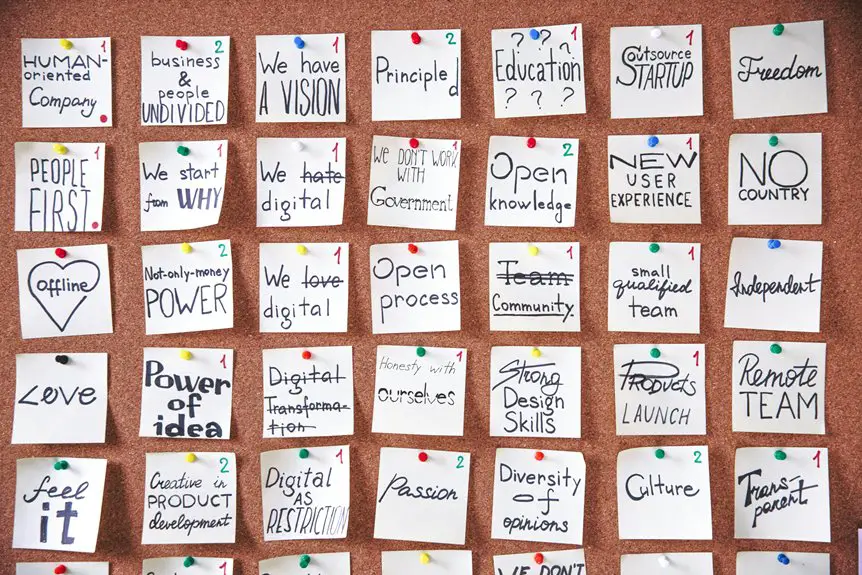You might not realize that over 70% of companies are now leveraging advanced technologies to reshape their work environments. This shift isn’t just about keeping up with trends; it’s about enhancing efficiency and innovation. From artificial intelligence to cloud computing, each technology plays an essential role in this transformation. What you might find surprising is how these tools can redefine not just productivity, but the very nature of work itself.
Table of Contents
Key Takeaways
- Artificial Intelligence and Machine Learning analyze data patterns, enhancing decision-making, operational efficiency, and personalized customer experiences.
- Cloud Computing enables flexible resource scalability, remote collaboration, and secure real-time data access, transforming workplace dynamics.
- Automation tools streamline repetitive tasks, boost productivity, and reduce human error, allowing teams to focus on strategic initiatives.
- Cybersecurity solutions safeguard digital assets through robust threat detection and encryption, ensuring secure transactions and data protection.
- The Internet of Things (IoT) connects devices for real-time data monitoring, driving automation and improving operational efficiency in organizations.
Artificial Intelligence and Machine Learning
Artificial Intelligence (AI) and Machine Learning (ML) are revolutionizing how businesses operate and make decisions. You’re likely seeing the impact of these technologies in various aspects of your work.
With AI, you can automate repetitive tasks, freeing up your time for more strategic initiatives. ML algorithms analyze vast amounts of data, revealing patterns and insights that help you predict trends and improve customer experiences. By harnessing these technologies, you can enhance decision-making processes and increase efficiency.
Additionally, AI-driven tools enable personalized marketing, allowing you to tailor your approach based on individual customer preferences. As you embrace AI and ML, you’re not just keeping up; you’re positioning your business for success in an increasingly competitive landscape.
Cloud Computing
As businesses increasingly adopt AI and ML, they also turn to cloud computing to enhance their capabilities.
Cloud computing offers you the flexibility to scale resources on demand, allowing your team to collaborate seamlessly from anywhere. With a reliable cloud infrastructure, you can store and access data securely, ensuring real-time updates and minimizing downtime.
Cloud computing provides on-demand resource scalability, enabling seamless collaboration and secure, real-time data access for your team.
This technology helps you reduce costs by eliminating the need for extensive on-premises hardware and maintenance. Additionally, cloud services provide robust backup solutions to protect your valuable information.
By leveraging cloud computing, you can focus on innovation rather than managing IT resources, empowering your workforce to be more productive and agile in an ever-changing digital landscape.
Embracing the cloud is essential for staying competitive in today’s business environment.
Automation
While digital transformation reshapes industries, automation stands out as a game-changer that streamlines processes and boosts efficiency.
By automating repetitive tasks, you can free up valuable time for your team to focus on higher-value activities. Imagine reducing human error and accelerating workflows—automation makes this possible.
With technologies like robotic process automation (RPA) and artificial intelligence (AI), you can enhance productivity in various areas, from data entry to customer service. This shift not only cuts costs but also improves accuracy and speed.
As you embrace automation, you’ll find that your organization becomes more agile and responsive to market demands.
Ultimately, investing in automation equips you with the tools to thrive in a rapidly changing work environment.
Collaboration Tools
Collaboration tools are essential for modern workplaces, helping you stay connected and engaged with your team.
With enhanced communication platforms, remote team engagement becomes seamless, fostering productivity no matter where you are.
Plus, document sharing solutions streamline your workflow, making it easy to collaborate in real-time.
Enhanced Communication Platforms
Effective communication is essential for any organization aiming to thrive in today’s fast-paced digital landscape. Enhanced communication platforms empower you to connect seamlessly with team members, regardless of location. These tools streamline collaboration, making it easier to share ideas, files, and feedback in real time.
| Feature | Benefit |
|---|---|
| Instant Messaging | Quick responses and clarity |
| Video Conferencing | Face-to-face interaction |
| File Sharing | Centralized access to documents |
| Task Management | Organized workflow |
| Integration | Compatibility with other tools |
Remote Team Engagement
In a world where remote work is becoming the norm, keeping your team engaged goes beyond just communication. You need to leverage collaboration tools that foster interaction and creativity.
Video conferencing platforms allow for face-to-face engagement, making discussions more personal and effective. Instant messaging apps help maintain a continuous flow of conversation, ensuring everyone stays connected and informed.
Utilizing project management tools can clarify goals, track progress, and celebrate achievements, which boosts morale.
Don’t forget to incorporate fun elements like virtual team-building activities or casual hangouts. By actively engaging with your team through these tools, you create a sense of community, making remote work not just productive but enjoyable.
Embrace these technologies to enhance your team’s collaboration and connection.
Document Sharing Solutions
Many teams find that document sharing solutions are essential for seamless collaboration, especially in a remote work environment. These tools not only streamline communication but also enhance productivity. By using document sharing solutions, you can easily collaborate on projects, track changes in real-time, and guarantee everyone’s on the same page.
Here’s a quick comparison of popular document sharing tools:
| Tool | Key Features |
|---|---|
| Google Drive | Real-time editing, cloud storage |
| Dropbox | File syncing, sharing links |
| Microsoft OneDrive | Office integration, security features |
| Box | Collaboration tools, file versioning |
Utilizing the right document sharing solution can transform your team’s workflow, making collaboration efficient and effective.
Cybersecurity Solutions
As you navigate the digital landscape, robust cybersecurity solutions become essential for protecting your assets.
You need effective threat detection technologies and data protection strategies to guard against ever-evolving cyber threats.
Prioritizing these solutions not only secures your information but also boosts your organization’s resilience.
Threat Detection Technologies
While organizations increasingly rely on digital platforms, the threat of cyberattacks looms larger than ever. To combat this, you need robust threat detection technologies that identify and neutralize risks before they escalate.
Solutions like intrusion detection systems and threat intelligence platforms can help you stay one step ahead of cybercriminals. These tools analyze network traffic and monitor user behavior, allowing you to detect anomalies promptly.
Malware detection and endpoint security solutions provide additional layers of defense, ensuring that your systems remain secure. By implementing these technologies, you can enhance your organization’s cybersecurity posture.
Data Protection Strategies
After establishing a solid threat detection foundation, it’s essential to focus on data protection strategies that safeguard your organization’s sensitive information.
Start by implementing strong encryption practices for data at rest and in transit. This guarantees that even if data is intercepted, it remains unreadable.
Next, adopt access control measures to limit who can view or modify sensitive information. Regularly update your software and systems to protect against vulnerabilities.
Additionally, consider using data loss prevention (DLP) tools to monitor and control data transfers. Educating your employees about security best practices is critical, too.
Finally, establish an incident response plan to quickly address any breaches. By taking these steps, you’ll greatly enhance your organization’s data security posture.
Big Data and Analytics
Big data and analytics are revolutionizing how organizations operate and make decisions. You’re empowered to access insights that drive innovation, enhance customer experiences, and boost efficiency.
With the right tools, you can turn vast amounts of data into actionable strategies, transforming challenges into opportunities.
- Discover patterns that reveal hidden customer needs
- Optimize operations for increased productivity and lower costs
- Predict trends that keep you ahead of competitors
- Foster data-driven cultures that enhance collaboration
- Make informed decisions that lead to sustainable growth
Embracing big data and analytics isn’t just about numbers; it’s about creating a future where your organization thrives in an ever-evolving landscape.
Don’t miss out on the chance to harness the power of information!
Internet of Things (IoT)
The Internet of Things (IoT) is transforming the way you interact with your environment by connecting everyday devices to the internet. This connectivity allows you to gather and analyze data in real-time, making your operations more efficient.
The Internet of Things is revolutionizing interactions with our environment through real-time data connectivity and enhanced operational efficiency.
For instance, smart sensors can monitor equipment performance, alerting you to potential issues before they escalate. You can automate routine tasks, freeing up your time for more strategic work.
Additionally, IoT enhances collaboration by enabling seamless communication between devices and systems, creating a more integrated workspace.
As you embrace IoT, you’ll find opportunities to innovate and improve your workflows, ultimately driving productivity and ensuring your organization stays competitive in a rapidly evolving digital landscape.
Remote Work Technologies
As remote work becomes increasingly common, leveraging the right technologies is crucial for maintaining productivity and collaboration. You need tools that connect you with your team and streamline workflows.
Embracing these solutions not only enhances efficiency but also fosters a sense of belonging, even from afar.
- Video conferencing platforms keep you face-to-face with colleagues.
- Instant messaging apps enable quick communication and idea sharing.
- Project management software helps track tasks and deadlines effortlessly.
- Cloud storage solutions guarantee your files are accessible anywhere, anytime.
- Time management tools assist in balancing work-life boundaries effectively.
Blockchain and Distributed Ledger Technology
While many people associate blockchain solely with cryptocurrencies, its potential extends far beyond that sector, revolutionizing various industries.
You can leverage blockchain and distributed ledger technology to enhance transparency and security in transactions. By using decentralized systems, you eliminate the need for intermediaries, reducing costs and increasing efficiency.
Leverage blockchain to boost transaction transparency and security while cutting costs and enhancing efficiency through decentralized systems.
These technologies can streamline supply chain management, ensuring traceability and authenticity of products. In the area of human resources, blockchain can simplify identity verification and secure employee records.
Additionally, smart contracts automate processes, ensuring compliance and reducing errors. As you embrace blockchain, you’ll find innovative solutions that drive digital transformation, making your organization more agile and competitive in today’s fast-paced environment.
Don’t underestimate the power of blockchain; it’s shaping the future of work.
Frequently Asked Questions
How Do These Technologies Impact Job Roles and Responsibilities?
These technologies change how you work, shifting your responsibilities and requiring new skills. You might find yourself collaborating digitally more often, adapting to automated tasks, and focusing on strategic thinking rather than routine operations.
What Skills Are Needed to Adapt to Digital Transformation?
To thrive through transformation, you’ll need technical tenacity, adaptability, and analytical acumen. Cultivating collaboration skills and creativity will also help you navigate new digital landscapes, ensuring you’re equipped for evolving roles in today’s workforce.
How Can Small Businesses Leverage These Technologies Effectively?
To leverage technologies effectively, you should assess your business needs, invest in user-friendly tools, train your team, and continuously adapt your strategies. This approach guarantees you maximize efficiency and stay competitive in today’s market.
What Are the Potential Downsides of Digital Transformation?
Digital transformation can lead to job displacement, security risks, and over-reliance on technology. You might find it challenging to adapt to rapid changes, which could strain resources and impact employee morale if not managed carefully.
How Do These Technologies Enhance Employee Engagement and Satisfaction?
These technologies boost employee engagement and satisfaction by streamlining communication, fostering collaboration, and providing flexible work options. You’ll notice increased motivation and productivity as teams connect more effectively and feel empowered in their roles.




